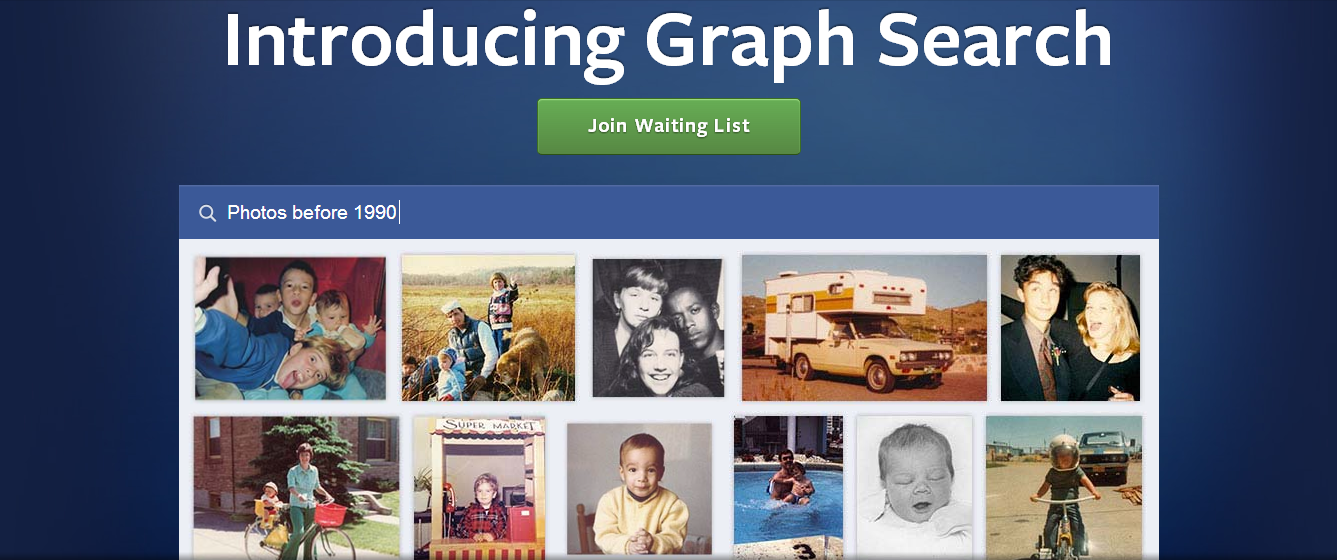 Facebook’s new Graph Search.
Facebook’s new Graph Search.
Facebook quietly issued a warning this week to its UK users – reminding people to check privacy settings before its powerful new “Graph Search” function arrives.
‘Great for helping to promote your business on Facebook but maybe an invasion of privacy too far for your personal account!’
Facebook quietly issued a warning this week to its UK users – reminding people to check privacy settings before its powerful new “Graph Search” function arrives.
Graph Search will be here in days – but Facebook’s warning does little to explain the power of its new tool, which makes it easy for people to find old photographs, even ones hidden from your Timeline.
Privacy group Electronic Frontier Foundation has described the new search function as “creepy”.
Users in the UK will be able to use it within days – to use the powerful search tool, people simply have to change their settings to “U.S. English”.
People are already using Graph Search – so tidy up your profile now
Graph Search makes it far easier to search through old photographs – and people who have signed up for early tests are using it already. If you’re worried about something you may have “Liked” or a photo you might be tagged in, act now. People in the U.S. and the UK are already using Graph Search and millions more will start using it within weeks.
For a quick fix, visit your profile
Graph Search will not show off any photos that are set to be private – ie ones that can be seen by “Only Me” or “Friends”. It won’t change privacy settings for any image – it’s just easier to find images, especially old ones, which used to require scrolling back through Timeline. You can adjust settings for photos on Activity Log (found on your profile page). If you’re worried, this is a great first step.
Be wary of “tagging”
Photos which friends have “tagged” you in can be found far more easily using Graph Search – even ones that don’t appear on your Timeline. If you’re worried, visit Facebook’s Activity Log (on your profile) and manually review photos that might be visible to others, hiding ones you don’t like. Graph Search will not show off private photos. You can also set Facebook’s Privacy settings so that you have the option to “Review” images where someone has tagged you before that tag appears on Facebook.
Understand how Graph Search works
The new tool makes Facebook searchable like much of the internet (it’s actually powered by Microsoft’s Bing). People can search for, say, a name and “Photographs”, and will see every image that person has been tagged in, or search for “London” and see images and “Likes” tagged in that location. It means a lot of Facebook content that users might have forgotten about is now easily available.
Don’t trust your Timeline
Posts that are hidden from your Timeline can be found by Graph Search – for instance by someone searching your name and “Photographs”. The only thing that counts is that photograph’s privacy settings, which determine whether it is visible to people in Graph Search.
Don’t assume that everyone sees the same thing
Graph Searches are personalised to each user – much in the same way as Facebook’s main News Feed is personalised to you. That means that people will tend to see results focused on their own friends. It also means, though, that you can’t be sure of what someone searching your name will see – it’s different for everyone. Lock down your privacy settings to be sure.
Learn how to use it
The best way to understand Graph Search’s power is to use it. Facebook suggests that you can use it to find “personalised” recommendations by searching, say, “Hotels in Madrid that my friends like” or “Friends of friends who live in Manchester”. For a career boost, the social network giant suggests searches such as “friends of friends who work at King.com”.
Watch what you’ve “Liked”
If you hit the “Like” button a lot, watch out. People can search for what you’ve “Liked” using Graph Search – humour sites on the web have already used the search to highlight lists of people who use dating apps and who are also listed as “married”. Visit your profile, go to Activity Log, then remove any “Like” you wouldn’t want others seeing.
Don’t hand out extra information
Information that was previously only visible by going to your profile page – such as where you’re from – can now be searched via Graph Search. Consider making your Profile information private so that you don’t show up in searches for a particular location – otherwise you may show up in searches by people you don’t know. The same also applies to any location-based apps such as Foursquare.
Watch out for “Friends of Friends”
Graph Search makes it much easier to find information about you – so you should seriously consider raising privacy settings so that “Only Friends” can see your photos. If your privacy is set to “Friends of Friends” or “Public”, people you don’t know will be able to see your photographs, posts and Likes.
This could mean that private information is available to employers or even cybercriminals.

